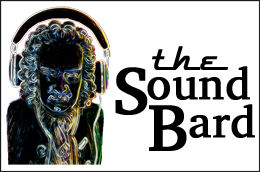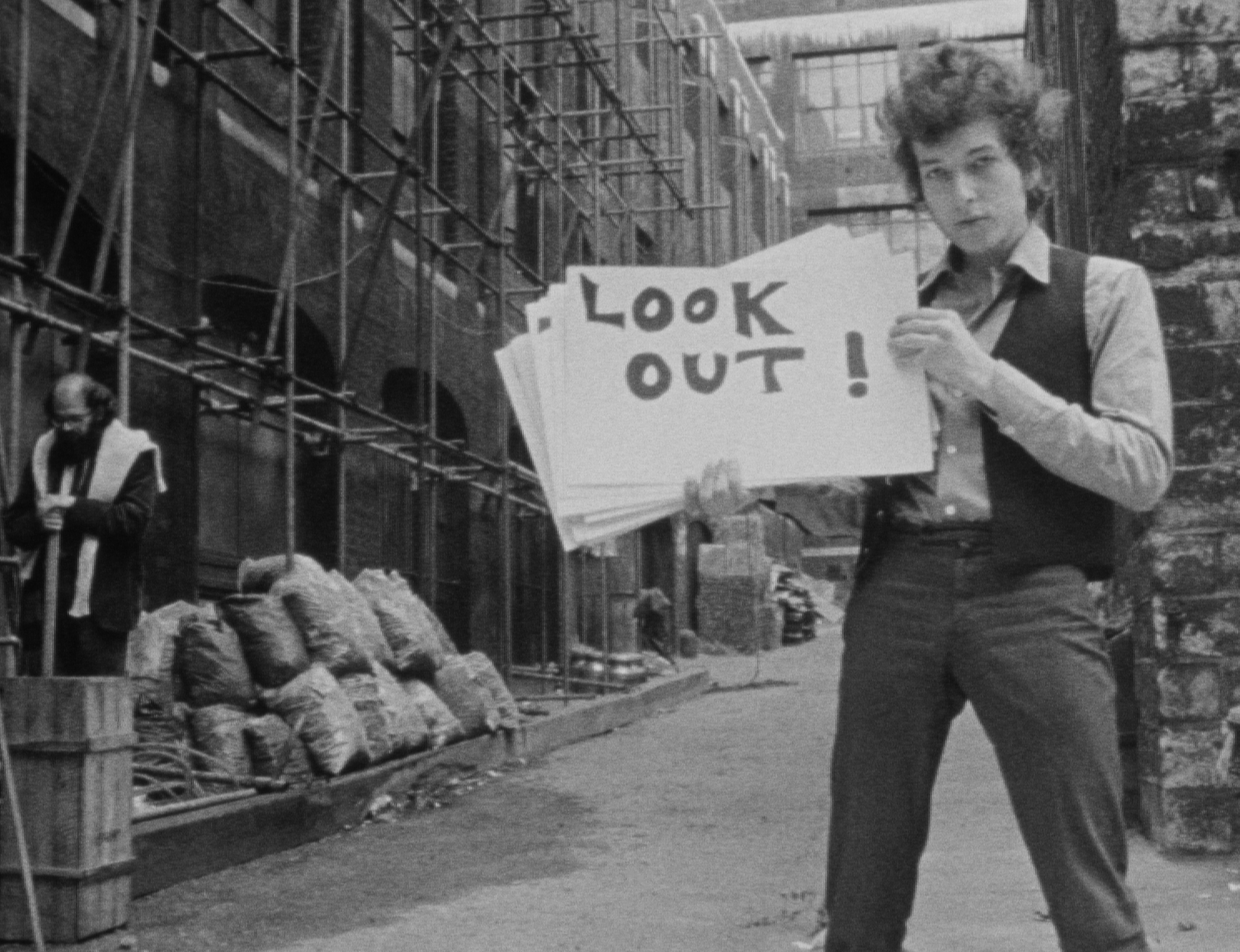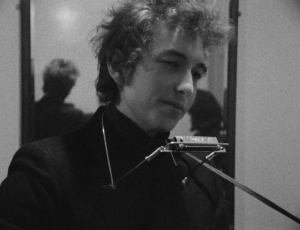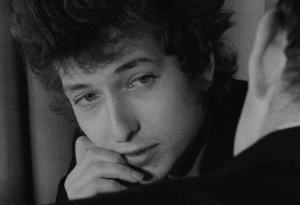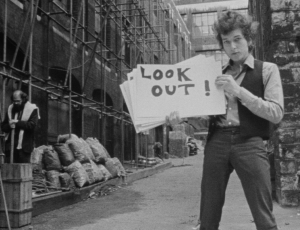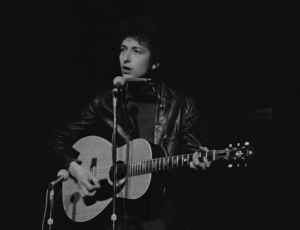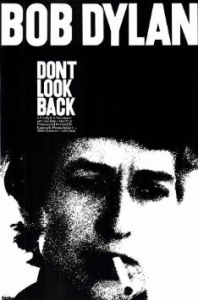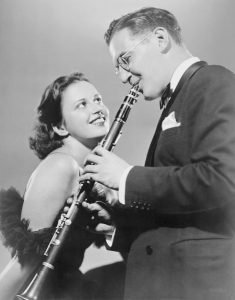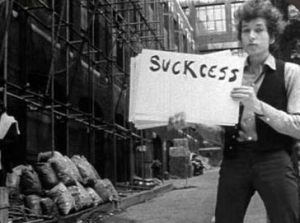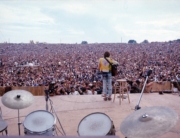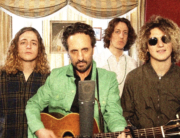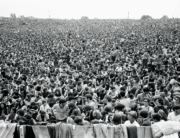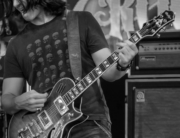BY MIKE METTLER — NOVEMBER 27, 2015
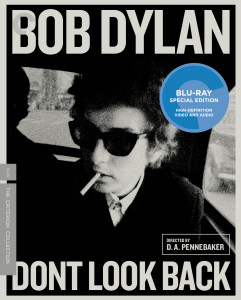 As iconic as it remains a full half-century later, when Bob Dylan: Dont Look Back was being shot by director D.A. Pennebaker during the Bard’s whirlwind tour of England in May 1965, there were literally no rules to follow. “It’s the idea of the home movie, the kind of movie that was always made by one person,” says Pennebaker, still as sharp as ever at age 90. “I had gotten the notion in my head not to make a pure music film. I decided to make it about him, right at the time he was he was trying to figure out who he was.”
As iconic as it remains a full half-century later, when Bob Dylan: Dont Look Back was being shot by director D.A. Pennebaker during the Bard’s whirlwind tour of England in May 1965, there were literally no rules to follow. “It’s the idea of the home movie, the kind of movie that was always made by one person,” says Pennebaker, still as sharp as ever at age 90. “I had gotten the notion in my head not to make a pure music film. I decided to make it about him, right at the time he was he was trying to figure out who he was.”
It’s beyond understatement to say Dont Look Back (apostrophe very deliberately missing; more on that later) set the bar for rock and pop-culture documentaries, a style that’s still very much followed today. “That’s the way it’s all done now,” Pennebaker agrees. “In that hotel room, there was nobody with me to take sound, so I just stuck the recorder in the middle of the room and turned it on, and I just hoped for the best. Now, everybody wants to get a piece of the action. Sometimes it works, sometimes it doesn’t. Everybody learns from it.”
It seems almost too easy to think that’s how the pure narrative of Dont Look Back emerged, given today’s uber-ubiquitous selfie-centric society, but the concept of shooting reality anything was simply not the norm a half-century ago. But thanks to the level of trust Dylan granted Pennebaker on that myth-making May 1965 tour, Dont Look Back, which first hit theaters in May 1967, shows the folk poet creating the legend in real time while being very much entrenched in his element: sometimes relaxed and playful, other times mischievous and challenging, and always absolutely riveting onstage during performance. “I think it interested him that I paid so much attention to him,” Pennebaker theorizes. “I filmed a lot of songs just by myself; a lot of the concerts. I filmed bits of the songs, but I recorded all of the songs, so we have audio for all of them.”
To celebrate the documentary’s golden anniversary, The Criterion Collection has done it again with a director-approved special edition that contains a restored 4K transfer, as well as restored monaural sound taken from Pennebaker’s original quarter-inch magnetic masters, presented uncompressed on Blu-ray. In addition to carrying over bonus material from previous releases, new extras — such as an evaluation of the evolution of Pennebaker’s lensing style, D.A. and onetime Dylan tour manager/compatriot Bob Neuwirth analyzing why they worked together so well on this and other tours, and Patti Smith talking about how the film influenced her both personally and professionally — all make this one of the best historical Blu-ray offerings, well, ever.
Pennebaker was a veritable fount of fascinating information about Dont Look Back and his own pioneering in-the-moment documentary-filming techniques, so we’re going extra long with this one. Here, D.A. and I discuss how he gained Dylan’s trust, the way he predicted the selfie culture, why he had to get on his back to shoot certain live performances, his thoughts on surround sound when it comes to film soundtracks, and the origin of the film’s legendary opening cue-card sequence. Give the anarchist a cigarette — D.A. is actually out of the basement, but still mixing up the medicine.
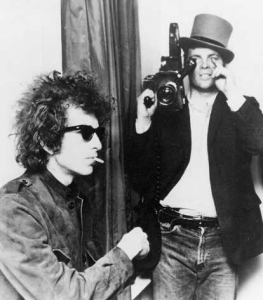
Men and Machines: Dylan and Pennebaker, with his 16mm Auricon handheld/shoulderheld camera, both hard at work creating myths and legends, in 1965.
Mike Mettler: OK, D.A., we will have to look back, despite the title. For one thing, I’ve been enjoying the new bonus material on the Blu-ray. I especially like how you and Bob Neuwirth talk about the 1967 New York Times review where the writer [Donal J. Henahan, on September 7, 1967] says, “It will be a good joke on us all if, in fifty years or so, Dylan is regarded as a significant figure in English poetry.” Interesting how that all turned out, right?
D.A. Pennebaker: Well, that’s true. That was always interesting about him. (chuckles)
Mettler: While you were working on the film, you must have felt the weight of how significant that English tour was for him in many ways.
Pennebaker: I was intrigued by it. It was surprising to me, because most of the people at the concert we shot at the theater in London [at the Royal Albert Hall, May 9-10, 1965] — they were so unlike the American audience he had. They were older and much more mature, and really interested in the poetics of what he was doing, rather than just the celebrity of it.
Mettler: You guys also said Dylan fit in much more with the English traditions of folk because of their history, so they were more ready to embrace the style of what he was doing.
Pennebaker: Yeah, well, for them, he was like the early version of Keats or Shelley. He used language in the kind of original way that always catches your ear when you hear it. You kind of wonder, “What did he say??” (chuckles)
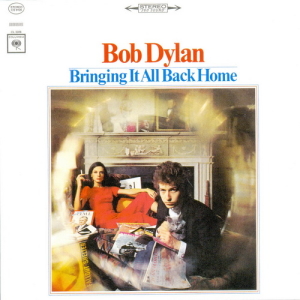 Mettler: Is there any one particular lyric that was the lightbulb line for you, the one that made you go, “I’ve gotta follow this guy”?
Mettler: Is there any one particular lyric that was the lightbulb line for you, the one that made you go, “I’ve gotta follow this guy”?
Pennebaker: There are a couple of things that he did, both speaking normally, and in a song. There’s one phrase that particularly struck me: “She’s true, like ice, like fire” [a line from “Love Minus Zero/No Limit,” from March 1965’s Bringing It All Back Home]. Just the whole way it was worded. That just struck me as an original piece of language.
Mettler: In terms of the picture restoration, the film looks so good on the new Criterion Collection Blu-ray. As a visual person, how do you feel about it 50 years later after you shot it? How does it look to your eye today?
Pennebaker: It’s very good, isn’t it? Well, it looks beautiful. I had to do it in black and white because there was no color then; color came in 2 years later. And it was very risky, because I was using an English lab – and luckily, it was a very good lab.
I was pushing all of the material, because I would load a magazine in [my 16mm Auricon handheld camera], and then we would shoot half of it in the hotel, and then the next day we would be outside shooting the other half, so I had to fix one speed for all of the film — everything. It was a push stop; two stops. And I didn’t use any lights at all; I didn’t have any. I used whatever it was in the room, or outside, or in the car. Like I said, you felt it was all a little risky (chuckles), but it depended on the labs.
The original stuff was good, but then I had to make a 35 [mm] blow-up, and that took a while. Some of the film got damaged and it was cut kind of hard, because I was trying to do it inexpensively, which was maybe a mistake. But we had to distribute it ourselves, because we didn’t have a distributor. We ran it in a porn theater out in San Francisco [the Presidio Theater, May 16, 1967]. We had a 16 [mm] print that ran there for almost a year, just that print. There wasn’t enough money for us to get a 35 blowup for when we opened up in New York.
Mettler: Right, at the 34th Street East Theater [in September 1967]. Do you think Dont Look Back could have worked in color? I think the black and white makes much more sense.
Pennebaker: No, I liked the black and white, and I was used to it, so I didn’t even think about color. Two years later, I did do a color film with Bob, and that was interesting too, but it was quite different.
Mettler: Yeah, some of that stuff from the European tour was part of the extras, the stuff somebody else directed — well, he directed, I mean.
Pennebaker: Dylan got in the middle of trying to make a film out of it, but he was not — it’s really hard for somebody who’s good at something else to concentrate totally for a long period of time on making a film. It’s not easy. So that film, which was called Eat the Document [shot in Europe in 1966], hasn’t really survived. But it’s interesting. Some of the footage was fantastic. Marty [i.e., Martin Scorsese], did pick up on some of it, and he made a film out of it. Not all of it; some of it.
Mettler: Yeah, he used some of that footage in No Direction Home (2005).
Pennebaker: Right. At the time we shot it, I thought it was too bad, because that footage is just going to end up in a box somewhere. I didn’t know what to do with it because Dylan said, “You’ve got your film, and now I want to make one myself.” That was a situation where I wasn’t interested in fighting about the film. It didn’t seem to be worth it.
Mettler: It’s all historical footage, especially at this point, so I hope it gets released someday.
Pennebaker: Oh yeah, yeah. Eventually, it will see the light of day. Eventually, everybody knows everything. (both laugh) I don’t think it’s lost. Some of the performance stuff is really quite interesting, and so different from the black and white. I actually made a lens myself, a wide-angle lens to use on the camera [done by modifying an old Switar lens and putting a big reduction glass in front, and shooting with Kodak Ektrachrome 7242 film]. I got on the stage with him. Some of that stuff is quite different, and not anything you could do in black and white.
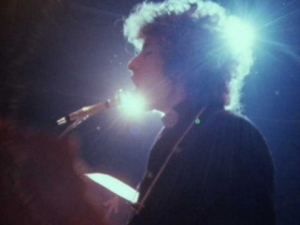
You Have a Halo Around You, Don’t You…: Dylan performing “Ballad of a Thin Man,” from Eat the Document.
Mettler: That’s when we see him playing “Ballad of a Thin Man” [from August 1965’s Highway 61 Revisited] at the piano in one of the extras, and you’re right there practically in his face, where we see that halo effect on him. He’s out there with a full band at that point [The Hawks, who’d later be known as The Band].
Pennebaker: Yeah, yeah. The idea of being with a band, he felt protected. By himself, he’d gotten kind of lonely, I think. When they were editing it, he and Robbie [Robertson, of The Hawks/The Band] were sort of arguing over which shot to use — this shot, or a shot of Robbie playing guitar. He kind of fell out with Robbie over that.
Performers often don’t know what a film is, because, in a sense, they think what they’re doing is somehow happening on another planet. And the film is a separate thing. By the time it gets to the film, they’re on to doing something else.
Mettler: You say it very well in the commentary and some of the other interviews I’ve seen you do — you’re there watching. And you’re better at watching and observing.
Pennebaker: Right, and they’re not watching — they’re playing.
Mettler: Yes, and your job as the filmmaker, director, and editor is to get the truth.
Pennebaker: This is a new kind of film. There were no rules at that point, and it was like a new adventure — and for me, particularly, because I was making the film all by myself. And later, at Monterey, I had five or six other people working with me, and they were all friends; I didn’t hire cameramen to do all that. I hired people I knew who knew how to use the camera we had made, which was important. [SoundBard FYI: “Monterey” here being the Monterey International Pop Festival, held June 16-18, 1967 at the Monterey County Fairgrounds in California, which Pennebaker shot for the film that became Monterey Pop that debuted in theaters on December 26, 1968. The Criterion Collection released Monterey Pop in Blu-ray form as part of The Complete Monterey Pop Festival box set.]
Mettler: You had a certain empathy, when you were filming — is that the right word for it?
Pennebaker: Yeah, it is. It was like doing something for the first time, so no one was quite sure how to do it.
Mettler: And now it’s become the blueprint for how to shoot rock documentaries. That goes all the way back to Baby (1954), the short film you shot with your daughter, with the balloon and the merry-go-round.
Pennebaker: Yeah, right. That was my first home movie! I learned a lot about what to do, and also what not to do.
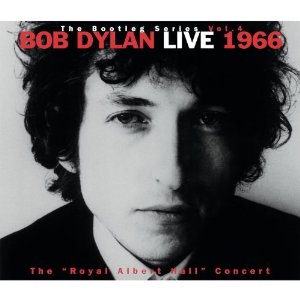 Mettler: And when he’s called a Judas — do you have footage of that moment?
Mettler: And when he’s called a Judas — do you have footage of that moment?
Pennebaker: Yeah, we do. [SoundBard FYI: That infamous sequence occurred at the Free Trade Hall in Manchester, England, on May 17, 1966. After an audience member yells out “Judas!” following the conclusion of “Ballad of a Thin Man,” Dylan replies, “I don’t believe you… you’re a liar!” Then he tells the band, “Play it fuckin’ loud!” before they go into “Like a Rolling Stone” to close the set. This performance can be found as part of the additional material on The Bootleg Series Vol. 4: Bob Dylan Live 1966, The “Royal Albert Hall” Concert, which was released in 1998.]
Mettler: Was it your wife who said in one of the new extras the difference between 4×3 framing and widescreen framing changed the way you see faces onscreen now?
Pennebaker: I think you adapt as things change. It’s like a painter. As painters get more abstract, it’s interesting to see what that’s like, and you try it. People instruct each other; that’s what makes it work.
Mettler: Is widescreen freeing to you, or just a different animal?
Pennebaker: I’m looking at everything through a camera, and I’ve got a zoom lens that can make the screen larger or smaller, so I can kind of do that within the camera, and make my decisions as I watch it. The wider screen and the wider image — it’s something you adapt to rather quickly. It gives you the possibility of having two things going on at the same time, where, with the smaller screen, you pretty much concentrated on what was in the middle.
Mettler: And you’re a pioneer in using the zoom lens, which hadn’t been used a whole lot at that point.
Pennebaker: You had to, because there was no way you were going to be able to change lenses while you were shooting.
Mettler: You created a number of cameras on your own, out of necessity.
Pennebaker: We had to build it to get a sync sound camera, because there was no sync camera you could carry around. That’s what we had to build.
Mettler: And now everyone in the universe can just pull out a phone and start filming. Does that seem “right” to you?
Pennebaker: I sort of imagined that would happen. There’s such a difference between these incredibly arranged and directed films that you see in the movie houses that come from Hollywood to what you do in your own house or your backyard. I always thought that was just as interesting to people — it just needs to be technically proficient. And when it was, then everybody took to it.
I think they work best when the filmmaker is actually exploring, and they’re using the camera as a device for exploring. It tends to be the most interesting. People have different ways of doing it, and sometimes it surprises you. It’s like animation. It’s showing something that’s not alive, but sometimes, it becomes very lifelike. And that’s always a surprise.
I like the idea that these films can surprise you. Most of the time, the scripted film really doesn’t surprise you. It becomes a theatrical concept, totally. That in itself, when it’s good, is fantastic, but it’s also very defining. It doesn’t allow for much error or mistake. And the home movie can allow for a lot of things to go wrong, and still work.
Mettler: One thing one of your cameramen, Jim Desmond, says is that it’s a matter of trust, so that you can get those honest, exploratory moments. How did you feel you were able to establish trust with “Mr. D,” as you’ve called him?
Pennebaker: I think he didn’t think much about it. I was part of the people who were around him. We didn’t set up stuff for the camera. We didn’t set up lights; we didn’t have tripods or any of the “normal” equipment that accompanies the filming process. So I think he thought it was kind of a throwaway.
Mettler: You weren’t intrusive.
Pennebaker: He didn’t think it was very serious, but he could tell what I was doing, because he could see me in the concert hall, particularly because I would be pretty close to where he was. When we did the one about the woman who got killed by the cane —
Mettler: Yeah, “The Lonesome Death of Hattie Carroll” [from January 1964’s The Times They Are A-Changin’].
Pennebaker: — in order to film that, I had to lie down in the aisle between the seats and look up at him. I couldn’t stand there in the middle of it, so I’d lay down on my back and film the whole thing from that position. That made me get a very good shot of his head, and I really wanted just to see him really close up, singing that song.
Mettler: It’s so powerful, and we as viewers feel we’ve earned being able to be that close when we get to that part of the film.
Pennebaker: And usually, when you hear a person singing at a concert, you want to see them up close. When we saw a film of him in Germany recently, they had one of those big blow-up screens behind him. They had very close head shots of him during the thing so the whole audience could see, and that was what I was trying to get on the film.
I could see that really worked for people, because they really weren’t interested in the rest of the scene. It wasn’t like they were watching a complicated thing taking place somewhere they didn’t know — they were watching the person sing, and they wanted to watch him as close as they could. And that’s what this kind of filming can do. And that’s what we did at Monterey, pretty much.
Mettler: Let’s talk about the beginning of the film. You don’t have any of those cue cards left over from the “Subterranean Homesick Blues” shoot, do you?
Pennebaker: I don’t have any of them now. They got blown all over London, when we tried to do it on the roof. There was a big wind.
Basically, it was an idea that Dylan had in a bar one night, and I thought it was a terrific idea. So we brought along all of those sharp cardboards. (chuckles) Joan Baez wrote out some of them; Donovan did a ton of them. He was a pretty good drawer, actually.
Mettler: Was there any kind of playback of the song while you shot it?
Pennebaker: When we shot it, we played it on a little Nagra [tape recorder] that we had sitting on the ground. When we were doing it, people were just giddy drunk, I guess. (chuckles)
Mettler: We have three different versions of the “Subterranean” clip on the Blu-ray.
Pennebaker: We tried one in the garden, and the cops came and threw us out. Then we decided to do it in the back alley, where there were no cops. For some reason, everybody got dressed up the next day, and we tried to do one up on the roof. And that’s when the wind blew all of the cards away, so I don’t think we ever got through it. Nobody really thought anything about it. I almost didn’t even put it in the film until it was almost released.
Mettler: Once you realized you were using it, was it always going at the beginning of the film?
Pennebaker: At first, I had him at the beginning saying, “You start off standing.” He was sort of saying it to himself in the dressing room before a concert. I thought that was a good place to start. When I was looking at the thing, we had a pretty long print of it made, and I thought, “That’s not going to work, because nobody knows who the hell he is. I’ve gotta get him onstage somehow.” But I remember the stuff we had shot, so I pulled it out, and I think we used everything. We didn’t edit anything, and just put it at the head of the film. It just seemed right. And then we used it later for the trailer.
Mettler: It’s perfect. And it’s something you can go back and watch and never get tired of seeing.
Pennebaker: That’s right. It was so interesting, because it told you everything you needed to know about Dylan before you watched the movie.
Mettler: Everything was destined to fit exactly how it fit.
Pennebaker: It wanted to happen. When you think about films, some of them want to happen, and some of them aren’t too sure.
Mettler: Another thing you and Bob Neuwith say in your joint interview is that this tour was essentially the first time that a man with just his voice, an acoustic guitar, and a harmonica onstage enraptured an entire room of people to that degree. It hadn’t really been done at that level before.
Pennebaker: Right — and in a non-stilted way. He was just up there like he’d walked off the street and onto the stage. He had the quality of being memorable.
Mettler: Do you have a particular favorite song of his?
Pennebaker: I like a lot of the songs. “Don’t Think Twice [It’s All Right]” is one. We’re using one of them in a film we’re doing now, one of the songs he did at Big Pink with The Band — “I Shall Be Released.” It’s one of my favorite songs, the version that Bob sings. [SoundBard FYI: That version was recorded in the Fall of 1967 in Woodstock, and was eventually released officially on The Bootleg Series Volumes 1–3 (Rare & Unreleased) 1961–1991.]
Mettler: Whenever he puts new material out, I think he’s still as vital a music creator now as ever.
Pennebaker: Oh yeah. My daughter was just in London and saw a concert of his, and wrote me back about it. Fantastic. That’s what he does. As he said, “I get out on the stage and sing for people — that’s what I do.” I always liked that quality.
Mettler: When was the last time you and Bob had a conversation?
Pennebaker: Not recently, but we talk sometime. We’re still partners. I haven’t had a talk with him for maybe 7 or 8 years, but we do talk once in a while. We don’t live in the same world.
Mettler: Did he ever express any of his impressions of Dont Look Back directly to you?
Pennebaker: No. At once point, he wanted to take out some of the drunken party scenes, and I persuaded him that would be hard to do. (chuckles heartily) I would be subject to worldwide despair, so he gave up on that.
Mettler: The audio quality of the film is quite good, even though you had to catch as catch can. For this Blu-ray version, you went back to the quarter-inch magnetic masters, right?
Pennebaker: Yeah, yeah. It took better equipment to do it. A friend of Dylan’s was doing the sound most of the time [Jones Alk, then wife of filmmaker and Dylan associate Howard Alk, who was also present]. I had a guy I brought with me to do the concerts [Bob Van Dyke], but he wasn’t always wandering around with me, but Jones was there. And Jones was terrific. You never see her with a mike or see her taping, because she was so sly and so good at it. That was a break for me, because I didn’t even know her before the trip.
Mettler: There’s one extra audioclip interview where Dylan says that Albert Grossman told him what the film was basically going to be, and that he had the trust that you could get it right.
Pennebaker: In the beginning, I think Albert had other ideas about what to do with whatever film we did. I don’t think he thought we’d be making a feature film out of it. But when he saw the poster, he changed. Then the film was fine.
Mettler: We have so many broad sonic choices now. How did you handle constructing the movie’s soundtrack at the time?
Pennebaker: Surround sound didn’t exist at that time, of course, and I was thinking about what to do to get this in the theater, because most of the theaters weren’t even set up right. The speakers didn’t work very well, so I just went for what I call “car stereo” — just left–right.
I had to mix it myself in New York, because there were no studios that could mix stereo. It was very early on in the process of making films, so we took what we could get. But at one point, about a year after it had been released, somebody said they were about to make a 4- or 5-track stereo mix of the film, and they’d do a reel for us to see what we’d think. I was interested to see how it sounded. In their studio, it sounded great.
We sent the reel down to a place where the film was playing, and the guy called up and said, “Take this out of here. I don’t want to hear it again, because the audience is revolting!” They had gotten so used to the other sound that when you put in all this “fancy” stuff, they hated it! I don’t know where that thread [mix] is, but it’s hidden away somewhere.
Mettler: And when quad came in, a lot of people had a hard time handling it.
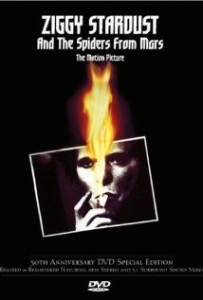 Pennebaker: I know. I think it got too complicated and lost some of the general uncertainty that good music should always have. You should wonder what the next note or sound will be. It should take you by surprise a little bit. When it gets too technically proficient, it loses that for me.
Pennebaker: I know. I think it got too complicated and lost some of the general uncertainty that good music should always have. You should wonder what the next note or sound will be. It should take you by surprise a little bit. When it gets too technically proficient, it loses that for me.
The Rolling Stones did one film in quad [1974’s Ladies and Gentlemen: The Rolling Stones]. We tried some stuff with the David Bowie film, The Spiders [i.e., 1973’s Ziggy Stardust and the Spiders from Mars: The Motion Picture]. The thing that was so extraordinary about the performance, the first time I heard it, was the entire theater [the audience at the Hammersmith Odeon in London, on July 3, 1973] was singing backup for him. I’d never heard anything like that! It had a monumental quality. And then people would yell certain phrases or words at him from different parts of the theater. So we tried to do that in the mix — to get that stereo in the theater off of the screen.
We showed it in Edinburgh [Scotland] because I was just making it on my own. Nobody wanted it. But Bowie heard about it, and it kinda worked, when you hear the people shouting. If you’re sitting in a seat, you’d hear it like they were not too far away from you. It’s not like the sound was coming from the screen. Bowie got interested in that, and he came over, and we became friends. (chuckles)
Eventually, he stayed here for a month, and we mixed it together. We had to go to the studio at 1 o’clock [a.m.], because that’s when they were closed. We’d go from 1 o’clock to about 5 in the morning for about a month, until we got the film mixed the way he liked it. I’ve been to some screenings recently, and it really is a beautiful film.
And that’s when he decided to drop out, after that show. He didn’t even realize we were filming it. We just did it on the spur of the moment.
Mettler: It’s a legendary thing at this point — “It’s the last show we’ll ever do” [Bowie’s comment before he and The Spiders performed “Rock N Roll Suicide”]. Even the rest of the band didn’t know it.
Pennebaker: That’s right. One of the Spiders was standing right behind me onstage and he said, “What?? What the hell was that??” He didn’t know he [Bowie] was going to quit.
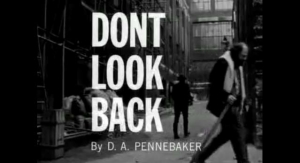
The film’s apostrophe-free title sequence, with Allen Ginsberg and his walking stick exiting at the right.
Mettler: And now, a language question. We don’t see the apostrophe in the word Dont in the title. That was deliberate, right?
Pennebaker: We got rid of it. It just seemed like an interesting thing. In England, they leave it out a lot, so I thought, “Why not here?” I just liked the idea of not having. If I did it today, I might have left it in; I don’t know.
Mettler: Did you get many comments about it?
Pennebaker: The New York Times used to not run it that way. Other people — little by little, it’s sort of became standardized. I didn’t have any point in doing it; I just did.
Mettler: Well, The New York Times still insists on spelling “disk” with a k in relation to “compact disk,” even though the format itself is compact disc with a c.
Pennebaker: I see. Well, language mostly comes from newspapers and magazines. We don’t see it expressed — but when we write letters or emails, who cares?
Mettler: Language is a bit more fluid these days, especially in the texting universe.
Pennebaker: My daughter changes words all of the time. It’s interesting that it’s acceptable to do that on emails, whereas you might not do that on a business letter. I love this one — MIR, which my daughter started using. “Mother In Room.” (chuckles) I love things like that.
Mettler: That’s a good one, just like NSFW [“Not Safe For Work”]. Do you still listen to vinyl records? Do you have time to?
Pennebaker: The vinyls aren’t as good as the 78s. They didn’t go as fast. That speed gave you a little quality on the 78 that made it work, even if it got noisy after a while. The English ones were especially terrific, and the French ones too. I have quite a lot of them, because I never throw them away. I still play them. My kids were raised on Fats Waller. They know all of his songs. (chuckles)
A musician I know, she didn’t know this music existed. When I played it for her, she almost cried because of how wonderful it sounded, and she felt deprived of it. I think that’s what happens. It’s a generational loss. I liked it when everybody around you knew the same songs.
Mettler: We don’t have that central radio conversation anymore. Everything is so fractionalized.
Pennebaker: That’s just too bad. When I was in college, there were a group of people, and we all knew the music. That was kind of neat. And if you got a new one, you could play it for people and they would appreciate it. I remember when Helen Ward stopped singing [with Benny Goodman, circa 1937], we all wrote a letter to her. We loved her so much. She was my favorite vocalist. I don’t know why she stopped. I thought they shouldn’t be allowed to stop! It’s like tearing down an old building.
But that whole music stopped, and it got rewoven by [Charlie] Parker — which was interesting, but it didn’t have the fluidity of the band music of [Artie] Shaw and Goodman and Larry Clinton. Those people gave it a kind of “this isn’t important, but listen to this” feel, but with Charlie Parker, every note was important. It changed the nature of the audience, I think, and the kind of music that was played publicly on a large scale.
Before that, you wouldn’t hear those bands on the radio; you’d go dance to them — at the old hotel on 40th Street, the Pennsylvania. Both the Dorseys [Tommy and Jimmy] and even Fletcher Henderson played there. We went there to hear them, you know? There was no other way to hear them. They might be on the radio at night, because sometimes they’d do these broadcasts at the hotels. Sometimes you’d hear four or five songs, and that was it. And you thought, “You know, I’d really like to hear that band,” so you went and bought the records, the 78s.
Mettler: Did you have a sense of where you were headed after you filmed Dont Look Back and Monterey Pop?
Pennebaker: I thought we — well, we had just started. We were working with Life magazine, and then quit in order to film what we were filming — the Johnny Come Latelys, and whatever we felt we could get away with. We knew we weren’t going to be able to sell it or get anybody to watch it, particularly, but we still did it.
But when I did the Dylan film, suddenly, there was a big audience waiting for it. And that changed what we were trying to do, but it didn’t help us any, because we couldn’t get any distribution, and we had to distribute both that and Monterey ourselves. We couldn’t find anybody to take the film, because it wasn’t like the kind of films they [the distributors] were used to doing. They didn’t want to change their ways. They were older, and this was “hippie shit” to them. They didn’t want to get into it.
Mettler: Fifty years from now, in 2065, when we’re probably all gone from this earth, how do you think people will look at Dont Look Back?
Pennebaker: I wonder about it. I always knew it would exist. Before Albert asked me if I wanted to go to England, I didn’t know anything about Dylan, really. I had heard one song on the radio — “The Times They Are a-Changin’,” maybe. I didn’t know who he was.
But when I met him and started hanging around with him, I started to think if I made this film out of this thing I was shooting, it would be the thing I would want, like if I had been able to make a film with [English poet Lord] Byron with [Percy and Mary] Shelley and all of those people in Pisa [where they all hung together from November 1821 to August 1822]. It would have been like the Haight. People would still be looking at that film. Nothing has ever been quite the same as Byron generated, in the world of writing. It was the end of poetry, and when Russian plays came in, people stopped getting their news out of poetry, and instead got them out of plays, and, eventually, out of novels.
So, Dylan to me seemed like an historical figure, and I could make a film people would be looking at long after we were all gone, because they’d want to know what times were like now, and that’s how they’d find it out. That was a huge feature in me wanting to make that film.
Mettler: And, like you said, you wanted the camera to not lie, and have it capture what was happening in the moment.
Pennebaker: Yeah. I like it when things are live. I rewrite nothing. We don’t even use the yellow pads. The camera is such an incredible instrument. When you point it at something, it can’t lie. You can try to trick it up, I guess, but I always think of it as a simple machine that does what it’s told. And it doesn’t fool you.
Tags: 16mm, 35mm, 4K, 78s, Alan Price, Albert Grossman, Allen Ginsberg, Ballad of a Thin Man, Benny Goodman, Big Pink, Blu-ray, Bob Dylan, Bob Neuwirth, Bob Van Dyke, Bringing It All Back Home, D.A. Pennebaker, David Bowie, Don't Look Back, Don't Think Twice Ma It's All Right, Donovan, Eat the Document, Helen Ward, Highway 61 Revisited, Howard Alk, Jim Desmond, Joan Baez, Jones Alk, Lord Byron, Love Minus Zero No Limit, LPs, Marianne Faithfull, Martin Scorsese, monaural, Monterey Pop, Nagra, No Direction Home, Patti Smith, quad, Robbie Robertson, Royal Albert Hall, Subterranean Homesick Blues, The Band, The Basement Tapes, The Criterion Collection, the Hawks, The Lonesome Death of Hattie Carroll, The Times They Are A-Changin, vinyl, Woodstock, Ziggy Stardust and The Spiders From Mars